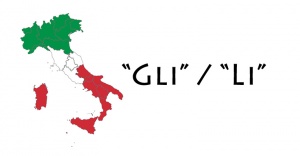Difference between revisions of "Language/Italian/Grammar/When-use-LI-and-GLI"
Jump to navigation
Jump to search
m (Some corrections to the English Text) |
|||
| Line 11: | Line 11: | ||
Example: | Example: | ||
*Hai visto i film di Fellini? Sì, '''li''' vedo sempre con grande piacere. | *Hai visto i film di Fellini? Sì, '''li''' vedo sempre con grande piacere. | ||
Have you | Have you seen the Fellini movies? Yes, I always watch them with great pleasure. | ||
==Gli== | ==Gli== | ||
| Line 19: | Line 19: | ||
Example: | Example: | ||
*Giuseppe ha freddo. Non '''gli''' hai dato la tua giacca ? | *Giuseppe ha freddo. Non '''gli''' hai dato la tua giacca ? | ||
Joseph is cold. | Joseph is cold. Didn't you give him your jacket? | ||
==References== | ==References== | ||
Revision as of 23:47, 12 October 2018
The difference between "gli" and "li" depends on the function of these two words in the sentense.
Both "gli" and "li" are used only for masculine.
Li
It is used as a pronoun in the construction of the direct object when it is masculine plural. For the masculine singular we use "lo". For the feminine singular we use "la" and for the feminine plural "le".
Example:
- Hai visto i film di Fellini? Sì, li vedo sempre con grande piacere.
Have you seen the Fellini movies? Yes, I always watch them with great pleasure.
Gli
It is used as a pronoun in the construction of the complement for a masculine singular. For the masculine plural form we use "a loro". For the feminine singular, we use "le" and feminine plural "a loro".
Example:
- Giuseppe ha freddo. Non gli hai dato la tua giacca ?
Joseph is cold. Didn't you give him your jacket?
